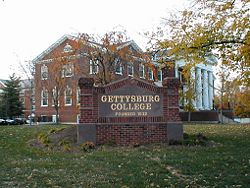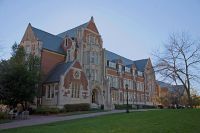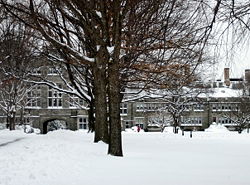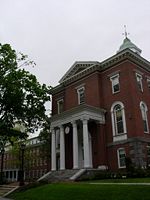Liberal arts college
Liberal arts colleges are post-secondary educational institutions which focus on a Liberal Arts curriculum, generally in undergraduate studies. Although the genesis for what is known today as the liberal arts college began in Europe, [1] the term is commonly associated with the United States, which has the largest concentration of Liberal arts schools, although such institutions can be found in countries all over the world as well.
Overview
In America, the designation of Liberal Arts College is given to schools that focuses on giving its undergraduate students a multi-facceted education, requiring study of subjects that fall into the categories of humanities, social and physical sciences.[2] The purpose of this kind of education is to develop a well rounded student, who has the intelluctual capacity to understand and utilize many different areas of intellectual thought and application. However, most liberal arts colleges allow, and some insist, that in addition to general studies, most students should also declare a major of study, one area in particular that the student can study more in-depth and focus upon. For example, a liberal arts student who decides to major in Biology must still take foundation courses in other physical and social sciences, as well as humanities, but will likely progress upon a tiered system of more in-depth study to bring their understanding and experience in the field of biology to a higher level than any other part of the liberal arts curriculum. Majors are offered so that students are properly prepared to either enter the workforce with experience in a particular area or have completed the necessary coursework to continue their education in a more focused discipline. Still, the liberal arts education model is looked upon as not just producing well-rounded students, but also helps create citizens who are able to interact and contribute to a multifaceted and complex society.
Most universities and colleges in America have liberal arts curriculums. Some schools, like Community Colleges have both vocational and liberal arts programs. However, the designation of Liberal Arts College comes from the Carnegie Classification of Institutions of Higher Education, which classifies 228 schools in America as liberal arts schools.[3] They are known for being residential and for having smaller enrollment, class size, and teacher-student ratios than universities. These colleges also encourage a high level of teacher-student interaction at the center of which are classes taught by full-time faculty rather than graduate student TAs (who teach some of the classes at Research I and other universities). Most of the schools with this designation are private institutions, and tend to cost significantly more than state or public schools.[4]
History
In the history of education, the seven liberal arts comprised two groups of studies: the trivium and the quadrivium. Studies in the trivium involved grammar, dialectic (logic), and rhetoric; and studies in the quadrivium involved arithmetic, music, geometry, and astronomy. These liberal arts made up the core curriculum of the medieval universities. The term liberal in liberal arts is from the Latin word liberalis, meaning "appropriate for free men" (social and political elites), and they were contrasted with the servile arts. The liberal arts thus initially represented the kinds of skills and general knowledge needed by the elite echelon of society, whereas the servile arts represented specialized tradesman skills and knowledge needed by persons who were employed by the elite.
Liberal Arts curricula in Europe started to broaden during the age of the Renaissance, when the most famous and celebrated of the day, such as Leonardo Da Vinci, chose not to focus entirely upon one course of study or work, but to consistently cross discipline lines and study a variety of pursuits.[5]. This tradition lived on in European educational institutions for some time, if not as liberally applied as in the time of the Renaissance. However, during the Industrial Revolution, when technology was pushing towards the workforce with a specific set of skills, emphasis was once again placed upon educating the masses in a way that helped economic progress, particularly in regards to engineering and other technology-based fields. In America however, the "Yale Report of 1828" was produced in reaction to demands from society for education to start preparing students for the changing times. The Yale committee which put the report together concluded that a liberal arts curriculum, in which students were prepared for many different aspects of life, was more beneficial to other types, and thus Yale became one of the first schools to adopt a liberal arts program, which was then mirrored by other schools in the U.S.[6] However, it should be noted that at this early stage, liberal art schools were increasingly selective and expensive, so the vast majority of Americans did not benefit from this type of education. In fact, since its initial inception, liberal arts colleges in the U.S. have had a somewhat back and forth relationship with society. During the latter half of the twentieth century, the rise in vocational, professional and community colleges, along with research institutions, decreased the overall enrollment in liberal arts schools. True to the cyclical cycle, during the beginning of the twenty-first century, liberal arts schools were once again becoming more popular, which could be seen as a tendency in American society to have a dualistic workforce of both vocationally trained and liberal arts educated students.
Purpose and goals
Chapter One ("The Liberal Arts: What is a Liberal Arts Education and Why is it Important Today") of Howard Greene and Matthew Greene's, Hidden Ivies: Thirty Colleges of Excellence, defines the goals of a liberal arts education in the following manner:
- In a complex, shifting world, it is essential to develop a high degree of intellectual literacy and critical-thinking skills, a sense of moral and ethical responsibility to one's community, the ability to reason clearly, to think rationally, to analyze information intelligently, to respond to people in a compassionate and fair way, to continue learning new information and concepts over a lifetime, to appreciate and gain pleasure from the beauty of the arts and literature and to use these as an inspiration and a solace when needed, to revert to our historical past for lessons that will help shape the future intelligently and avoid unnecessary mistakes, to create a sense of self-esteem that comes from personal accomplishments and challenges met with success. [7]
In addition, college placement counselor, Loren Pope, suggests that at the liberal arts colleges he lists in Colleges That Change Lives,
- the focus is on the student, not the faculty; he is heavily involved in his own education. There are no passive ears; students and faculty work so closely together, they even coauthor publications. Teaching is an act of love. There is not only a mentor relationship in class but professors become hiking companions, intramural teammates, dinner companions, and friends. Learning is collaborative rather than competitive; values are central; there is a strong sense of community. They are places of great synergy, where the whole becomes greater than the sum of the parts. Aspirations are raised, young people are empowered."[8]
Organization
Consortia and groups
Liberal arts colleges are also often associated with larger groups or consortia. In the United States, many liberal arts colleges belong to the Annapolis Group, Oberlin Group, Women's College Coalition, and the Consortium of Liberal Arts Colleges. The Council of Public Liberal Arts Colleges is a consortium of public liberal arts colleges. A number of liberal arts colleges are involved in Project Pericles or the Eco League.
Regional
Well-known consortia in the Eastern United States include the Little Ivies, Little Three, and the Seven Sisters Colleges. Four Eastern colleges, along with the University of Massachusetts Amherst, are also part of the Five Colleges Consortium in Western Massachusetts and three Eastern colleges comprise the Tri-College Consortium.
Similar consortia include the Claremont College Consortium in Southern California and the Associated Colleges of the Midwest in the Midwestern United States.
Additional midwestern groups include the Five Colleges of Ohio, Associated Colleges of the Twin Cities, and the Great Lakes Colleges Association.
Groups in the Southern United States include the Associated Colleges of the South, and the Seven Sisters of the South.
Rankings
Two well known college and university rankings guides offer annual issues which rank liberal arts colleges. They are the U.S. News and World Report [1] and The Washington Monthly's "College Rankings" issue.[2]
2007 movement
On 19 June, 2007, during the annual meeting of the Annapolis Group, members discussed the letter to college presidents asking them not to participate in the "reputation survey" section of the U.S. News and World Report survey (this section comprises 25% of the ranking). As a result, "a majority of the approximately 80 presidents at the meeting said that they did not intend to participate in the U.S. News reputational rankings in the future." [9] However, the decision to fill out the reputational survey or not will be left up to each individual college as: "the Annapolis Group is not a legislative body and any decision about participating in the US News rankings rests with the individual institutions." [10] The statement also said that its members "have agreed to participate in the development of an alternative common format that presents information about their colleges for students and their families to use in the college search process." [11] This database will be web based and developed in conjunction with higher education organizations including the National Association of Independent Colleges and Universities and the Council of Independent Colleges.
On 22 June 2007, U.S. News and World Report editor Robert Morse issued a response in which he argued, "in terms of the peer assessment survey, we at U.S. News firmly believe the survey has significant value because it allows us to measure the "intangibles" of a college that we can't measure through statistical data. Plus, the reputation of a school can help get that all-important first job and plays a key part in which grad school someone will be able to get into. The peer survey is by nature subjective, but the technique of asking industry leaders to rate their competitors is a commonly accepted practice. The results from the peer survey also can act to level the playing field between private and public colleges." [12] In reference to the alternative database discussed by the Annapolis Group, Morse also argued, "It's important to point out that the Annapolis Group's stated goal of presenting college data in a common format has been tried before [...] U.S. News has been supplying this exact college information for many years already. And it appears that NAICU will be doing it with significantly less comparability and functionality. U.S. News first collects all these data (using an agreed-upon set of definitions from the Common Data Set). Then we post the data on our website in easily accessible, comparable tables. In other words, the Annapolis Group and the others in the NAICU initiative actually are following the lead of U.S. News." [13]
SAT optional movement
A number of liberal arts colleges have either joined, or have been important influences on, the SAT optional movement in the United States.
Bates College
In 1984, Bates College in Lewiston, Maine instituted an SAT optional program, which was one of the first in the United States. This was followed up in 1990, when the Bates faculty voted to make all tests optional in the college's admissions process. In October 2004, Bates published a study regarding the testing optional policy to the National Association for College Admission Counseling. Following two decades without required testing, the college found that the difference in graduation rates between submitters and non-submitters was 0.1%, that Bates' applicant pool had doubled since the policy was instated with approximately 1/3 of applicants not submitting scores, non-submitting students averaged only 0.05 points lower on their collegiate Grade Point Average, and applications from minority students raised dramatically.[14]
The Bates study prompted a movement among small liberal arts colleges to make the SAT optional for admission to college in the early 2000s.[15][16] Indeed, according to a 31 August, 2006 article in the New York Times, "It is still far too early to sound the death knell, but for many small liberal arts colleges, the SAT may have outlived its usefulness."[17]
Sarah Lawrence College
Sarah Lawrence College dropped its SAT test score submission requirement for its undergraduate applicants in 2003,[18] thus joining the SAT optional movement for undergraduate admission. The former president of Sarah Lawrence, Dr. Michele Tolela Myers, described the rationale for this decision in an article for The Washington Post on 11 March, 2007, saying, "We are a writing-intensive school, and the information produced by SAT scores added little to our ability to predict how a student would do at our college; it did, however, do much to bias admission in favor of those who could afford expensive coaching sessions.
At present, Sarah Lawrence is the only American college that completely disregards SAT scores in its admission process.[19] As a result of this policy, in the same Washington Post article, Dr. Myers stated that she was informed by the U.S. News and World Report that if no SAT scores were submitted, U.S. News would "make up a number" to use in its magazines. She further argues that if SLC were to decide to stop sending all data to U.S. News and World Report, that their ranking would be artificially decreased.[20][21] U.S. News and World Report issued a response to this article on 12 March 2007 that stated that the evaluation of Sarah Lawrence is under review.[22]
Additional colleges and FairTest
Additional SAT optional liberal arts colleges include Bard College, Bennington College, Bowdoin College, College of the Holy Cross, Connecticut College, Denison University, Dickinson College, Drew University,Founders College, Franklin & Marshall College, Goucher College, Gustavus Adolphus College, Hampshire College, Hamilton College, Knox College, Lake Forest College, Mount Holyoke College, Pitzer College, Smith College, [3] St. Lawrence University, and Wheaton College (Massachusetts).
The full list of SAT optional schools is given by Fairtest, [23] an American educational organization that "advances quality education and equal opportunity by promoting fair, open, valid and educationally beneficial evaluations of students, teachers and schools. FairTest also works to end the misuses and flaws of testing practices that impede those goals."[24]
Beyond the U.S.
Institutions outside the United States that have been inspired by U.S. liberal-arts colleges include International Christian University, which was established after World War II as the first American-style college in Japan, the European College of Liberal Arts in Germany, in the Netherlands three liberal arts colleges have been founded over the last decade, and Ashesi University in Ghana. This category of higher education does not exist in the United Kingdom, and the term "liberal arts" is very little used in any contemporary context in the UK.
While the concept is rarely expressed in Australia, it is presently becoming more influential in Melbourne. In that city, Victoria University now offers a two year "Diploma of Liberal Arts." Additionally, the University of Melbourne is becoming a US style graduate school, offering generalist undergraduate degrees similar to a liberal arts degree in the US
Notes
- ↑ Harriman, Philip (1935). Antecedents of the Liberal Arts College. The Journal of Higher Education.
- ↑ "liberal arts college." Encyclopedia of Education. The Gale Group, Inc, 2002. Answers.com 01 Jul. 2008. http://www.answers.com/topic/liberal-arts-college
- ↑ "liberal arts college." Encyclopedia of Education. The Gale Group, Inc, 2002. Answers.com 01 Jul. 2008. http://www.answers.com/topic/liberal-arts-college
- ↑ "liberal arts college." Encyclopedia of Education. The Gale Group, Inc, 2002. Answers.com 01 Jul. 2008. http://www.answers.com/topic/liberal-arts-college
- ↑ "liberal arts." The Columbia Electronic Encyclopedia, Sixth Edition. Columbia University Press., 2003. Answers.com 01 Jul. 2008. http://www.answers.com/topic/liberal-arts
- ↑ "liberal arts college." Encyclopedia of Education. The Gale Group, Inc, 2002. Answers.com 01 Jul. 2008. http://www.answers.com/topic/liberal-arts-college
- ↑ Green, Howard and Matthew Green. Hidden Ivies: Thirty Colleges of Excellence (New York: Harper Collins, 2000), 12
- ↑ Loren Pope. Colleges That Change Lives (New York: Penguin Group, 2006), 6
- ↑ Jaschik, Scott (20 June 2007). More Momentum Against ‘U.S. News’. Inside Higher Ed.
- ↑ ANNAPOLIS GROUP STATEMENT ON RANKINGS AND RATINGS. Annapolis Group (19 June 2007).
- ↑ ANNAPOLIS GROUP STATEMENT ON RANKINGS AND RATINGS. Annapolis Group (19 June 2007).
- ↑ Morse, Robert (22 June 2007). About the Annapolis Group's Statement. U.S. News and World Report.
- ↑ Morse, Robert (22 June 2007). About the Annapolis Group's Statement. U.S. News and World Report.
- ↑ SAT Study: 20 Years of Optional Testing. Bates College Office of Communications and Media Relations (October 1 2004).
- ↑ Not Missing the SAT. Inside Higher Ed (October 6 2006).
- ↑ More universities are going SAT-optional. USA Today (April 4 2006).
- ↑ Students’ Paths to Small Colleges Can Bypass SAT. The New York Times (August 31 2006).
- ↑ Sarah Lawrence College Drops SAT Requirement, Saying a New Writing Test Misses the Point. The New York Times (13 November 2003).
- ↑ U.S. News Statement on College Rankings. U.S. News and World Report (12 March 2007).
- ↑ Tolela Myers, Michele (11 March 2007). The Cost of Bucking College Rankings. The Washington Post.
- ↑ Would U.S. News Make Up Fake Data?. Inside Higher Ed (12 March 2007).
- ↑ U.S. News Statement on College Rankings. U.S. News and World Report (12 March 2007).
- ↑ SAT Optional 4-Year Universities = Fairtest.
- ↑ About Us.
ReferencesISBN links support NWE through referral fees
- Howard Greene and Mathew W. Greene (2000). Greenes' Guides to Educational Planning: The Hidden Ivies: Thirty Colleges of Excellence. New York: HarperCollins. ISBN 0-06-095362-4.
- Harriman, Philip. "Antecedents of the Liberal Arts College." The Journal of Higher Education. Vol. 6, No. 2 (1935): 63-71.
- Koblik, Steven and Stephen Richards Graubard. Distinctively American: The Residential Liberal Arts Colleges, 2000.
- Pfnister, Allen O. "The Role of the Liberal Arts College." The Journal of Higher Education. Vol. 55, No. 2 (March/April 1984): 145-170.
- Pope, Loren. Colleges That Change Lives. New York: Penguin, 2006.
- Reeves, Floyd W. "The Liberal-Arts College." The Journal of Higher Education. Vol. 1, No. 7 (1930): 373-380.
- Seidel, George. "Saving the Small College." The Journal of Higher Education. Vol. 39, No. 6 (1968): 339-342.
- Compiled and Edited by the Staff of the Yale Daily News (2007). The Insider's Guide to the Colleges, 2008 (34th edition). New York: St. Martin's Griffin. ISBN-13: 978-0-312-36689-6.
- Harriman, Philip. "Antecedents of the Liberal Arts College." The Journal of Higher Education. Vol. 6, No. 2 (1935): 63-71.
- Pfnister, Allen O. "The Role of the Liberal Arts College." The Journal of Higher Education. Vol. 55, No. 2 (March/April 1984): 145-170.
- Reeves, Floyd W. "The Liberal-Arts College." The Journal of Higher Education. Vol. 1, No. 7 (1930): 373-380.
- Seidel, George. "Saving the Small College." The Journal of Higher Education. Vol. 39, No. 6 (1968): 339-342.
External links
All links Retrieved June 10, 2008:
- Alphabetical listing of SAT optional schools; Listing of SAT optional schools by State.
- How To Choose a College That's Right For You - NPR
- Teens, parents should avoid College Selection Hysteria - The Capital
- The right college the right fit: is the perfect college out there waiting for you? Absolutely! But you need to do your research. Get introspective, check your facts, then go out and find it
- A Descriptive Analysis of the Community College Liberal Arts Curriculum
- Academic Commons
- CatholiCity: Catholic Encyclopedia
- Liberal Arts at the Community College
- Philosophy of Liberal Education
- The Center of Inquiry in the Liberal Arts
Credits
New World Encyclopedia writers and editors rewrote and completed the Wikipedia article in accordance with New World Encyclopedia standards. This article abides by terms of the Creative Commons CC-by-sa 3.0 License (CC-by-sa), which may be used and disseminated with proper attribution. Credit is due under the terms of this license that can reference both the New World Encyclopedia contributors and the selfless volunteer contributors of the Wikimedia Foundation. To cite this article click here for a list of acceptable citing formats.The history of earlier contributions by wikipedians is accessible to researchers here:
The history of this article since it was imported to New World Encyclopedia:
Note: Some restrictions may apply to use of individual images which are separately licensed.



